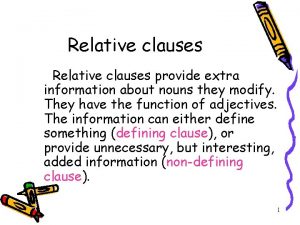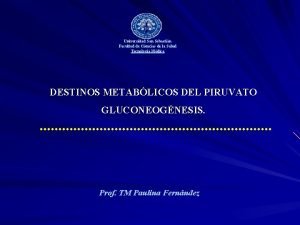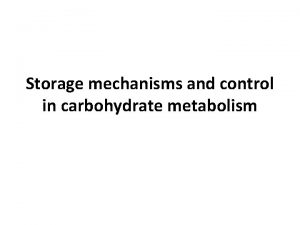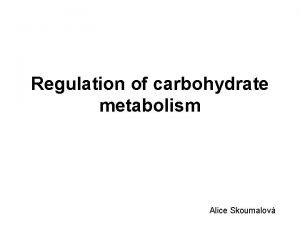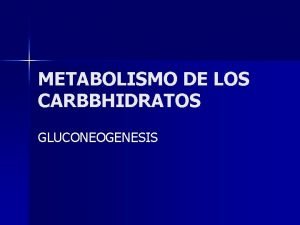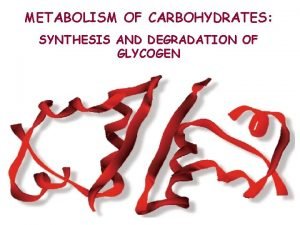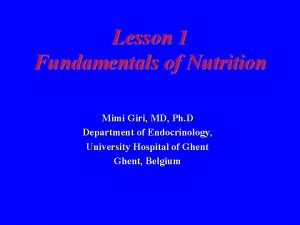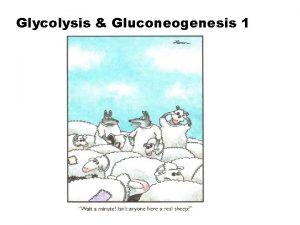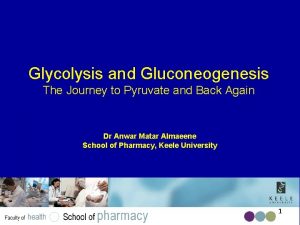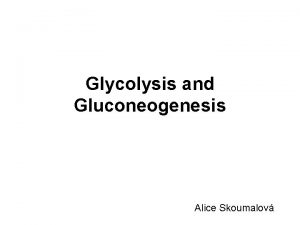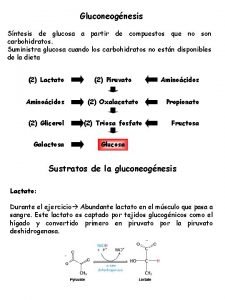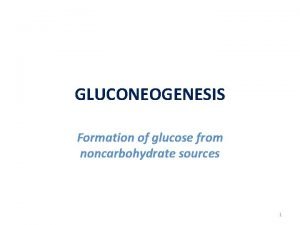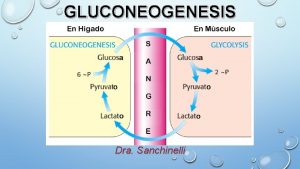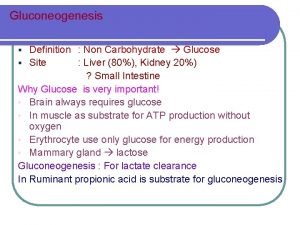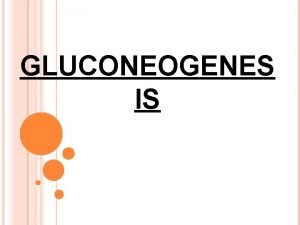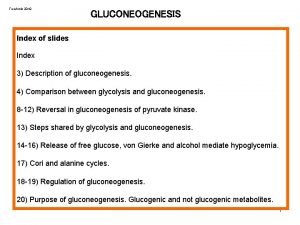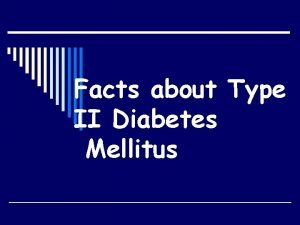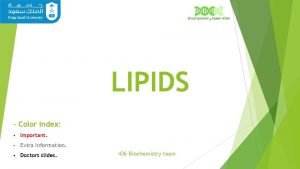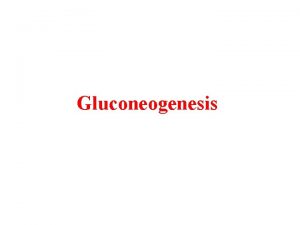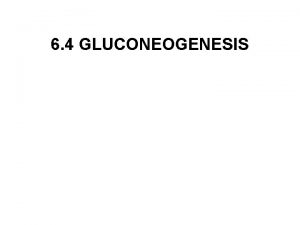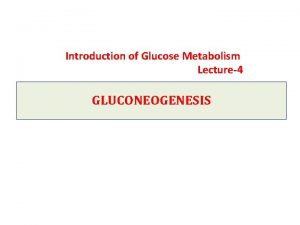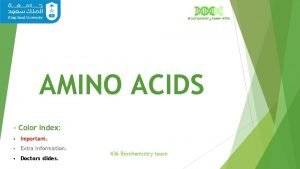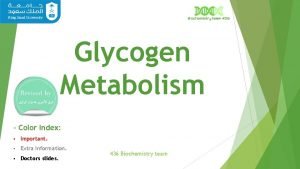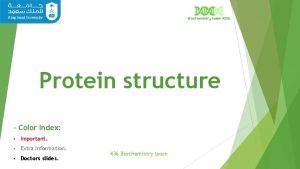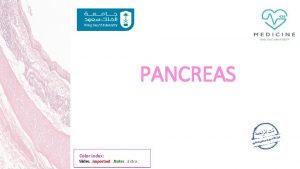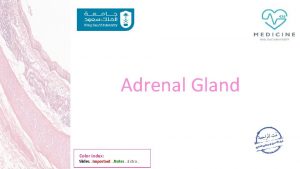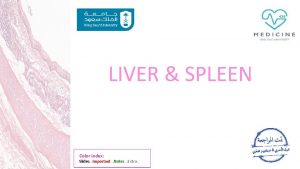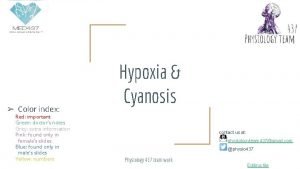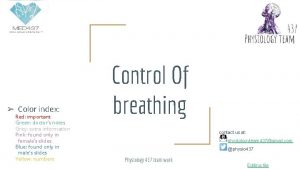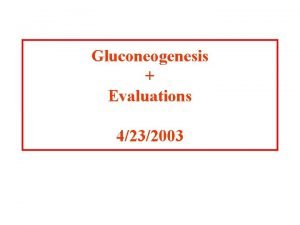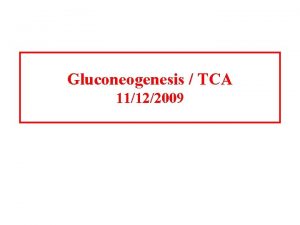Gluconeogenesis Color Index Important Extra Information Doctors slides




















- Slides: 20

Gluconeogenesis – Color Index: § Important. § Extra Information. § Doctors slides. 436 Biochemistry team

Objectives: Ø The importance of gluconeogenesis as an important pathway for glucose production Ø The main reactions of gluconeogenesis Ø The rate-limiting enzymes of gluconeogenesis Ø Gluconeogensis is an energy-consuming, anabolic pathway

Gluconeogenesis is an energy consuming, anabolic pathway. It is a metabolic pathway that results in the generation of glucose from certain noncarbohydrate carbon substrates. Gluconeogenesis is important to provide the body with glucose when there is no external source of glucose (during prolonged fasting or starvation). Occurs in Liver mainly, and in Kidney During Overnight fast: • 90% of gluconeogenesis occurs in liver • 10% of gluconeogenesis occurs in Kidneys. Gluconeogenesis occurs in both mitochondria and cytosol. EXCEPTION! if gluconeogenesis starts by Glycerol, …… it will need only the cytosol Our bodies will metabolize all glycogen stores within the first 18 hours of fasting, then will start looking for another source to make glucose Gluconeogenic substrates Glycerol The glycerol backbone is found in all lipids known as triglycerides Lactate pyruvate Produced from pyruvate via the enzyme lactate dehydrogenase in a process of fermentation during normal metabolism and exercise. a key intermediate in several metabolic pathways. Pyruvate can be made from glucose through glycolysis, converted back to glucose via gluconeogenesis Glucogenic amino acids A glucogenic amino acid is an amino acid that can be converted into glucose through gluconeogenesis. **Not all amino acids can make glucose there are certain types.

Gluconeogenesis Seven glycolytic reactions are reversible and are used in the synthesis of glucose from lactate or pyruvate. Three of the reactions are irreversible and must be reversed by four alternate reactions that energetically favor the synthesis of glucose. The 4 alternate reactions in gluconeogenesis to the 3 irreversible glycolytic steps: Glycolysis enzymes Gluconeogenesis enzymes Pyruvate kinase 1) Pyruvate carboxylase 2) PEP-CK PFK-1 3) Fructose 1, 6 bisphosphatase Glucokinase/Hexokinase 4) Glucose 6 -phosphatase ﻣﻮﺿﺤﺔ ﻓﻲ ﺍﻟﺼﻮﺭﺓ ﺑﺎﻟﻠﻮﻥ ﺍﻷﺤﻤﺮ ﻣﻮﺿﺤﺔ ﻓﻲ ﺍﻟﺼﻮﺭﺓ ﺑﺎﻟﻠﻮﻥ ﺍﻷﺰﺭﻕ

1. Glycerol: Glycerol is released during the hydrolysis of triacylglycerol in adipose tissue and is delivered by the blood to the liver. Important notes: • Glycerol kinase is only present in liver & kidneys • Gluconeogenesis of glycerol occurs only in the cytosol Glycerol Kinase ATP Gluconeogenic precursors are (non-carbohydrates) molecules that can be used to produce a net synthesis of glucose. Why can’t adipocytes phosphorylate glycerol? Because they essentially lack glycerol kinase. Glycerol 3 -phosphate ADP NAD+ Glycerol 3 -phosphate dehydrogenase NADH Dihydroxyacetone phosphate Glycerol #Recall Gluconeogenic Substrates: Lactate Glucogenic amino acids Pyruvate

Gluconeogenic Substrates: Glycerol 2. Lactate: Lactate is released into the blood by exercising skeletal muscle and by cells that lack mitochondria such as RBCs. In the Cori cycle, bloodborne glucose is converted by exercising muscle to lactate, which diffuses into the blood. The lactate is taken up by the liver and reconverted to glucose, which is released back into circulation. *Lactate is converted to pyruvate and then to glucose. Lactate Glucogenic amino acids Pyruvate

Gluconeogenic Substrates: Glycerol Lactate Glucogenic amino acids *The amino acids in the red boxes must be MEMORIZED along with the intermediates they produce Pyruvate 3. Glucogenic Amino Acids: The catabolism of glucogenic amino acids produces either: v pyruvate v Or one of the intermediates in the Krebs Cycle. For example; catabolizing asparagine produces oxaloacetate (an intermediate) which can be converted later to glucose. Pyruvate: Alanine, Glycine Intermediates: Glucogenic Amino Acid: Oxaloacetate Asparagine, Aspartate. Fumarate Phenylalanine, Tryosine. Succinyl-Co. A Methionine, Valine. a-ketoglutarate Glutamine (after it’s converted to glutamate. )

Pyruvate Carboxylation • • • The carboxylation occurs in the liver and kidney, exactly in Mitochondria. So Pyruvate has to travel from cytoplasm to mitochondria why ? Because Pyruvate carboxylase is only found in matrix of mitochondria. Glycerol *To compare * In glycolysis: to convert from PEP into Pyruvate we need just one enzyme which is ( Pyruvate Kinase ). Lactate Glucogenic amino acids Pyruvate General Idea Substrate: Pyruvate Chemical Reaction: Carboxylation Enzyme: Pyruvate Carboxylase Co-Enzyme: Biotin Product: Oxaloacetate *Intermediate* Pyruvate carboxylase: is an enzyme of the ligase class that catalyzes (depending on the species) the physiologically irreversible carboxylation of pyruvate to form oxaloacetate (OAA). Biton: coenzyme that makes CO 2 more active to bind. Gluconeogenic Substrates: Pyruvate Carboxylase Biotin Pyruvate In gluconeogenesis: to convert Pyruvate into PEP we need two enzymes in two steps these enzymes are (Pyruvate carboxylase + PEP-CK) *Explained in next slide* Oxaloacetate CO 2 ATP ADP + Pi


Pruvate Carboxylase and PEP-CK Pyruvate carboxylase + PEP-CK = Pyruvate kinase • Pyruvate Carboxylase is induced by Acetyl. Co. A *meaning that Acetyl-Co. A is an activator for the pyruvate carboxylation reaction* • • What happens during fasting? Acetyl-Co. A is increased via fatty acid oxidation (FAO)

Mentioned in Boys’ Lecture Only There are 3 ways for Oxaloacetate (OAA) to transport across the mitochondrial membrane: v OAA reduction to malate “as we mentioned previously” In the cytosol v OAA conversion to aspartate v OAA conversion to PEP (inside the mitochondria) OAA PEP

Gluconeogenesis Regulation: Overview: *EXTRA EXPLANATION* While most steps in gluconeogenesis are the reverse of those found in glycolysis, the 3 regulated and endergonic reactions in glycolysis are replaced. Glycolysis: Hexokinase/glucokinase, phosphofructokinase, and pyruvate kinase enzymes Gluconeogenesis: • PEP carboxykinase/pyruvate carboxylase. • Fructose-1, 6 -bisphosphatase • Glucose-6 -phosphatase These enzymes are typically regulated by similar molecules, but with opposite results. For example, acetyl Co. A and citrate activate gluconeogenesis enzymes, while at the same time inhibiting the glycolytic enzyme pyruvate kinase. This system: reciprocal control The majority of the enzymes responsible for gluconeogenesis are found in the cytosol; the exception is mitochondrial pyruvate carboxylase. Global control of gluconeogenesis is mediated by glucagon (released when blood glucose is low); Glucagon triggers phosphorylation of enzymes and regulatory proteins by Protein Kinase A (a cyclic AMP regulated kinase) resulting in inhibition of glycolysis and stimulation of gluconeogenesis.

Regulation of Pyruvate Carboxylase reaction Acetyl Co. A diverts pyruvate away from oxidation in Krebs cycle and toward gluconeogenesis How? High level of Acetyl-Co. A will inhibit PDH complex and stop or reduce the Glycolysi. And stimulate Pyruvate Carboxylase to start Gluconeogenesis. Pyruvate dehydrogenase complex: is a complex of three enzymes + positive regulation High Acetyl co. A will stimulate the enzyme pyruvate carboxylase to make more oxaloacetate Then, the oxaloacetate will produce more glucose -negative regulation High level of Avetyl-co. A inhibit PDH complex. PDH function: converts pyruvate carboxylase to Acetyl co. A Negative regulation: inhibition Positive regulation: activation NOTE ; Acetyl Co. A diverts pyruvate away from oxidation ( by PDH complex to produce acetyl co. A) and toward gluconeogenesis

The precise regulation of PFK 1 prevents glycolysis and gluconeogenesis from occurring simultaneously. Fructose 1, 6 -Bisphosphatase The rate of gluconeogenesis is controlled by key enzyme: fructose-1, 6 -bisphosphatase v Fructose 1, 6 bisphosphatase enzyme dephosphorylates (removes P group) Fructose 1, 6 Bi-phosphate. Which turns it into Fructose 6 -Phosphate. v ( - negative regulation) What inhibits this process? v AMP and Fructose 2, 6 bisphosphate The reverse reaction We took this in glycolysis: Phosphofructokinase-1 (PFK-1) is one of the most important regulatory enzymes of glycolysis. It is an allosteric enzyme controlled by many activators and inhibitors. PFK-1 catalyzes the important "committed" step of glycolysis, the conversion of fructose 6 phosphate and ATP to fructose 1, 6 -bisphosphate and ADP. *Fructose bisphosphatase (Gluconeogensis) catalyzes the reverse of the reaction which is catalyzed by phosphofructokinase-1 (glycolysis)*

Glucose 6 -Phosphatase v Glucose 6 - phosphate D-Glucose Done by Glucose 6 -phosphatase enzyme ( removal of phosphate group ) § Dephosphorylation of glucose 6 phosphate allows release of free glucose from the liver and kidney into blood. (when glucose is phosphylated they can not go outside the cell So. They need to Dephosphorylation to go from cell to circulation in blood to maintain blood sugar level ) Glucose 6 -phosphatase = Glucokinase is an enzyme that facilitates phosphorylation of glucose to glucose-6 phosphate.

Gluconeogensis: Energy- Consumed Six High-Energy Phosphate Bonds From Pyruvate to Glucose ( From purvate to Glucose ) • 2 Purvate convert to 2 Oxaloacetate • 2 GTP convert to 2 GDP • 2 (3 -Phosphoglycerate ) convert to 2(1. 3 bisphoglycerate) • 2 NADH converted to 2 NAD NET : -2 ATP -2 ATP 6 ATP 0 ATP

Gluconeogenesis: Regulation. • Reciprocal control Gluconeogenesis & Glycolysis • Allosteric: Acetyl Co. A + (Pyruvate carboxylase) AMP - or ATP + F 2, 6 -Bisphosphate • - F 1, 6 -bisphosphatase Glucagon ( I/G ratio) stimulates gluconeogenesis - Allosteric ( F 2, 6 -Bisphosphate) - Induction (PEP-CK) ( ﻭﺵ ﺗﻌﻨﻲ؟ Insulin/Glucagon ratio) ﺑﻴﻨﻤﺎ ﺍﻷﻨﺴﻮﻟﻴﻦ ﻳﺴﻮﻱ ، ﺍﻟﺠﻠﻮﻛﺎﺟﻮﻥ ﻳﻬﺘﻢ ﺑﺮﻓﻊ ﻣﺴﺘﻮﻯ ﺍﻟﺠﻠﻮﻛﻮﺯ ﺑﺎﻟﺪﻡ . . ﺍﻟﻌﻜﺲ ( ﻧﺤﺘﺎﺝ ﻳﻜﻮﻥ ﺍﻟﻤﻘﺎﻡ ﺍﻛﺒﺮ gluconeogenesis) ﻓﻠﺬﻟﻚ ﻟﺘﺤﻔﻴﺰ ﻋﻤﻠﻴﺔ . . ” ﻗﻴﻤﺔ ”ﺍﻟﺠﻠﻮﻛﺎﺟﻮﻥ” ﻣﻦ ﺍﻟﺒﺴﻂ “ﺍﻷﻨﺴﻮﻟﻴﻦ Important!!! Pyruvate carboxylase is only found in matrix of mitochondria Gluconeogenesis rate-limiting enzymes: v Pyruvate carboxylase v PEP-CK

Reciprocal control

MCQs + videos The main site of gluconeogenesis is : A- kidneys D- lymph node B- glycerol C- triglycerides D- glucogenic amino acid Gluconeogenesis and glycolysis are reciprocally uncontrolled A- true C- spleen Which one of the following is not a gluconeogenesis substrate? A- lactate B- liver B- false Anabolic pathway consumes ATP for synthesis of glucose A- true B- false Reactions of glycolysis : https: //youtu. be/h. Dq 1 rh. Uk. V-g Regulation of gluconeogenesis and glycolysis : https: //youtu. be/0 ep. Bvl 0 HTe. Y 1234 - B C B A

 A small child slides down the four frictionless slides
A small child slides down the four frictionless slides Robert pushes the box to the left
Robert pushes the box to the left Relative clauses extra information
Relative clauses extra information Extra information clauses
Extra information clauses Relative clause with extra information
Relative clause with extra information Precursores de gluconeogenesis
Precursores de gluconeogenesis Examples of physical function of art
Examples of physical function of art Glycogenolysis and gluconeogenesis
Glycogenolysis and gluconeogenesis Gluconeogenesis sustrato y producto
Gluconeogenesis sustrato y producto Glycogenolysis vs gluconeogenesis
Glycogenolysis vs gluconeogenesis Gluconeogenesis purpose
Gluconeogenesis purpose Gluconeogenesis
Gluconeogenesis Gluconeogenesis irreversible steps
Gluconeogenesis irreversible steps Precursor of gluconeogenesis
Precursor of gluconeogenesis Glucosa
Glucosa Gluconeogenic enzymes
Gluconeogenic enzymes Precursores de gluconeogenesis
Precursores de gluconeogenesis Gluconeogenesis definition
Gluconeogenesis definition Glucogenic amino acid
Glucogenic amino acid Net reaction of gluconeogenesis
Net reaction of gluconeogenesis Glycogenolysis and gluconeogenesis
Glycogenolysis and gluconeogenesis




